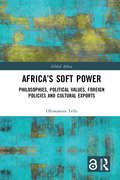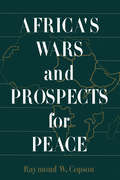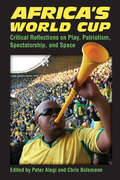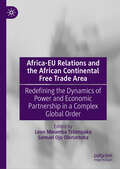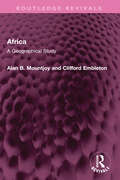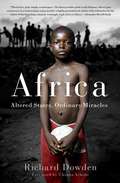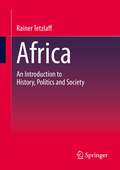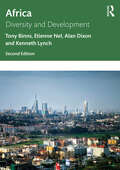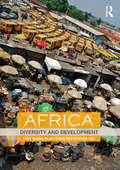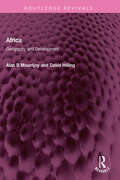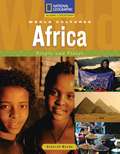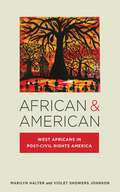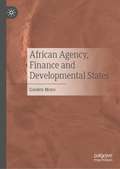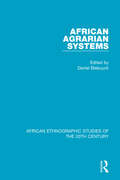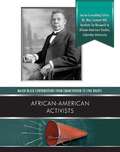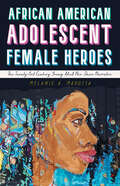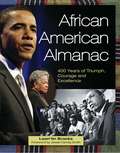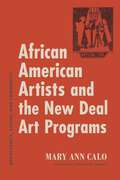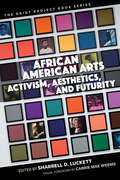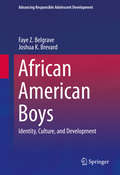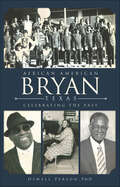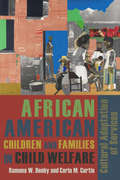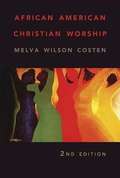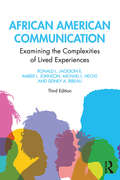- Table View
- List View
Africa's Soft Power: Philosophies, Political Values, Foreign Policies and Cultural Exports (Global Africa)
by Oluwaseun TellaThis book investigates the ways in which soft power is used by African countries to help drive global influence. Selecting four of the countries most associated with soft power across the continent, this book delves into the currencies of soft power across the region: from South Africa’s progressive constitution and expanding multinational corporations, to Nigeria’s Nollywood film industry and Technical Aid Corps (TAC) scheme, Kenya’s sport diplomacy, fashion and tourism industries, and finally Egypt’s Pan-Arabism and its reputation as the cradle of civilisation. The book asks how soft power is wielded by these countries and what constraints and contradictions they encounter. Understandings of soft power have typically been driven by Western scholars, but throughout this book, Oluwaseun Tella aims to Africanise our understanding of soft power, drawing on prominent African philosophies, including Nigeria’s Omolúwàbí, South Africa’s Ubuntu, Kenya’s Harambee, and Egypt’s Pharaonism. This book will be of interest to researchers from across political science, international relations, cultural studies, foreign policy and African Studies.
Africa's Wars and Prospects for Peace
by Raymond W. CopsonA collection of articles addressing the issue of whether the industrial model of human progress can be sustained in the long term. It asks what the social, political, economic and environmental implications as well as potential solutions to the problem of resource-intensive growth are.
Africa's World Cup: Critical Reflections on Play, Patriotism, Spectatorship, and Space
by Peter Chris Alegi BolsmannAfrica s World Cup: Critical Reflections on Play, Patriotism, Spectatorship, and Space focuses on a remarkable month in the modern history of Africa and in the global history of football. Peter Alegi and Chris Bolsmann are well-known experts on South African football, and they have assembled an impressive team of local and international journalists, academics, and football experts to reflect on the 2010 World Cup and its broader significance, its meanings, complexities, and contradictions. The World Cup s sounds, sights, and aesthetics are explored, along with questions of patriotism, nationalism, and spectatorship in Africa and around the world. Experts on urban design and communities write on how the presence of the World Cup worked to refashion urban spaces and negotiate the local struggles in the hosting cities. The volume is richly illustrated by authors photographs, and the essays in this volume feature chronicles of match day experiences; travelogues; ethnographies of fan cultures; analyses of print, broadcast, and electronic media coverage of the tournament; reflections on the World Cup s private and public spaces; football exhibits in South African museums; and critiques of the World Cup s processes of inclusion and exclusion, as well as its political and economic legacies. The volume concludes with a forum on the World Cup, including Thabo Dladla, Director of Soccer at the University of KwaZulu-Natal, Mohlomi Kekeletso Maubane, a well-known Soweto-based writer and a soccer researcher, and Rodney Reiners, former professional footballer and current chief soccer writer for the Cape Argus newspaper in Cape Town. This collection will appeal to students, scholars, journalists, and fans. Cover illustration: South African fan blowing his vuvuzela at South Africa vs. France, Free State Stadium, Bloemfontein, June 22, 2010. Photo by Chris Bolsmann. "
Africa-EU Relations and the African Continental Free Trade Area: Redefining the Dynamics of Power and Economic Partnership in a Complex Global Order
by Samuel Ojo Oloruntoba Leon Mwamba TshimpakaThis book examines the establishment and implementation of the AfCFTA, which is the largest free trade area globally, covering 54 African countries. It explores how this initiative has the potential to reshape Africa-EU relations by promoting intra-African trade, economic integration, and diversification, as well as inter- regional trade. Both continents have potential to serve as global actors in reshaping the global order in ways that can affect how multilateralism foster inclusive development. However, whether this will happen would be a function of how the EU and AU define their interests and relationship.
Africa: A Geographical Study (Routledge Revivals)
by Clifford Embleton Alan B MountjoyFirst published in 1965, Africa provides a geographical, political, economic and social description of the continent. Contemporary Africa is a continent of change and revolutions. The diversity and limitations of the African environment gives us a fuller understanding of the explosive dynamism of the African economic and social scene. This book will be of interest to students of geography, economy, anthropology and political science.
Africa: Altered States, Ordinary Miracles
by Chinua Achebe Richard DowdenAfter a lifetime's close observation of the continent, one of the world's finest Africa correspondents has penned a landmark book on life and death in modern Africa. In captivating prose, Dowden spins tales of cults and commerce in Senegal and traditional spirituality in Sierra Leone; analyzes the impact of oil and the internet on Nigeria and aid on Sudan; and examines what has gone so badly wrong in Zimbabwe, Rwanda, Burundi, and the Congo. From the individual stories of failure and success comes a surprising portrait of a new Africa emerging--an Africa that, Dowden argues, can only be developed by its own people. Dowden's master work is an attempt to explain why Africa is the way it is and calls for a re-examination of the perception of Africa as "the dark continent." He reveals it as a place of inspiration and tremendous humanity.
Africa: An Introduction to History, Politics and Society
by Rainer TetzlaffThe textbook provides an in-depth overview of African history and politics from the Atlantic slave trade, through the phases of colonialism and decolonization, to the development problems of the present. Various development theories are used to explain successful and failed development paths of individual countries after 1960. Thematic foci include Europe's colonial legacy, state formation and state failure, democratization, the curse of raw materials, population growth, hunger and poverty, ethnic conflicts, and the roles of the World Bank, EU, and China as external actors in Africa.
Africa: Diversity and Development
by Tony Binns Etienne Nel Alan Dixon Kenneth LynchAfrica: Diversity and Development introduces and de-mystifies Africa’s diversity and dynamism, and considers how its peoples and environments have interacted through time and space. The book examines the background and diversity of Africa’s social, cultural, economic, political and environmental systems, as well as key development issues which have affected Africa in the past and are likely to be significant in shaping the future of the continent. These include: the impact of HIV/AIDS; sources of conflict and post-conflict reconstruction; the state and governance; the nature of African economies in a global context and future development trajectories. This second edition features new chapters on history and governance, health, separate chapters on rural and urban development and updated content on all aspects of the continent, particularly aspects of culture and ethnicity. It is richly illustrated throughout with diagrams and plates and contains a wealth of detailed up-to-date case studies and current data. This textbook is a refreshing interdisciplinary text which enhances understanding of the background to Africa’s current position and clarifies possible future scenarios. It will be a valuable resource for students taking modules on Africa, African Development and Geography of Africa, and will also prove useful to students in the wider fields of Geography, Development Studies, Global Studies, Environment and Society and African Politics.
Africa: Diversity and Development (Country Fact Files Ser.country Fact Files)
by Tony Binns Etienne Nel Alan DixonFor many, Africa is regarded as a place of mystery and negative images, where reports of natural disasters and civil strife dominate media attention, with relatively little publicity given to any of the continent’s more positive attributes. Africa has at last begun to receive the depth of interest it has long deserved, in the shape of debates about trade, aid and debt, the ‘Make Poverty History’ campaign, and the UK's ‘Commission on Africa’. But, behind the superficial media façade, Africa is a diverse, complex and dynamic place, with a rich history and a colonial engagement that, although short-lived, was fundamental in determining the long-term future of the continent. At the start of the second decade of the twenty-first century, when the world is engulfed in a major financial crisis, Africa has the dubious distinction of being the world’s poorest continent. This book introduces and de-mystifies Africa’s diversity and dynamism, and considers how its peoples and environments have interacted through time and space. The background and diversity of Africa’s social, cultural, economic, political and environmental systems is examined, as well as key development issues which have affected Africa in the past and are likely to be significant in shaping the future of the continent. These include: the impact of HIV/AIDS; sources of conflict and post-conflict reconstruction; the state and governance; the nature of African economies in a global context and future development trajectories. Africa: Diversity and Development is a refreshing interdisciplinary text which enhances understanding of the background to Africa’s current position and clarifies possible future scenarios. It is richly illustrated throughout with diagrams and plates, and contains a wealth of detailed case studies and current data.
Africa: Geography and Development (Routledge Revivals)
by David Hilling Alan B MountjoyFirst published in 1988, Africa examines the varied pattern of development in the continent, the progress and the disappointments experienced, and the prospects. This picture is set firmly within the frame of the continent’s geography. From a general synthesis, the books moves to a country by country analysis of the interdependence of geography and economic development. The authors’ analysis of the effects of varied development strategies in Africa leads them, in the final section, to discuss what lessons maybe learned from these earlier initiatives and to assess the changes in development policies that were later implemented. This book will be of interest to students of geography, economics and development studies.
Africa: People and Places (World Cultures)
by Deborah MeadeEncourage students to look through the book, matching cultural themes such as Arts and Sports with the titles of articles. Urge them to pay special attention to the photographs, captions, graphics, and article summaries. Tell students Explain that Africa: People and Cultures presents a series of articles that combine to produce a broad picture of Africans ways of life.
African & American: West Africans in Post-Civil Rights America (Nation of Nations #24)
by Marilyn Halter Violet Showers JohnsonExamines what it means to be African and American through the stories of recent West African immigrantsAfrican & American tells the story of the much overlooked experience of first and second generation West Africanimmigrants and refugees in the United States during the last forty years. Interrogating the complex role of post-colonialism in the recent history of black America, Marilyn Halter and Violet Showers Johnson highlight the intricate patterns of emigrant work and family adaptation, the evolving global ties with Africa and Europe, and the translocal connections among the West African enclaves in the United States.Drawing on a rich variety of sources, including original interviews, personal narratives, cultural and historical analysis, and documentary and demographic evidence, African & American explores issues of cultural identity formation and socioeconomic incorporation among this new West African diaspora. Bringing the experiences of those of recent African ancestry from the periphery to the center of current debates in the fields of immigration, ethnic, and African American studies, Halter and Johnson examine the impact this community has had on the changing meaning of “African Americanness” and address the provocative question of whether West African immigrants are, indeed, becoming the newest African Americans.
African Agency, Finance and Developmental States
by Gorden MoyoThis book is an open invitation to the enterprise of re-imagining an alternative decolonial development project in Africa. It does this by focusing on the triple themes of African agency, development finance, and African developmental states in the context of an emerging multipolar world system. The book must be read as an affirmatively disruptive inquiry into the twin evils of global coloniality and global capitalist economic relations that have kept Africa on the lower rungs of the global pecking order, thereby preventing the rooting of an alternative development paradigm on the continent. As such, the book seeks to contribute towards the project of extricating the financing of development in Africa from the clutches of the Global North and the emerging powers of the Global South. In this way, it is a call for Afro-rebellion against the old and new forms of global coloniality and global capitalism. While the book is of major interest to scholars and students of African Studies, Development Studies, International Development Cooperation, International Relations, International Trade and Investment, Diplomacy, Africa–China Relations, and Political Science, it is equally meant for the general reader as it assumes no prior knowledge in any of the field of enquiry other than interest in the development of the African continent.
African Agrarian Systems
by Daniel BiebuyckOriginally published in 1963 this volume surveys various aspects of the complex relations between rights in land, social organization and economic interests in tropical Africa. The papers - in English and French but with summaries in the other language - analyse case studies illustrating the various basic factors and problems connected with land in Tropical Africa. Indigenous systems of tenure and their adaptation to commercial agriculture, the balance between rights and obligations of groups and individuals, and the authority and duties of chiefs and headmen are discussed in detail for many different areas. Against this background important contributions are made towards the better understanding of problems raised by economic and political development, population increase, migration and scarcity of land.
African American Activists (Major Black Contributions from Emancipat)
by Carol EllisThe Civil War finally ended slavery in the United States in 1865. But blacks didn't suddenly enjoy all the rights other Americans took for granted. They had to struggle against racism and discrimination to claim those rights. African-American Activists traces that generations-long struggle. In this book, you'll meet early activists like Booker T. Washington and W. E. B. Du Bois, who had very different ideas about how blacks should take their place in American society. You'll read about activists who worked for integration and equality under the law during the civil rights movement, including Rosa Parks and John Lewis. And you'll learn how a new generation of African-American activists, such as Majora Carter and Van Jones, continue to work for a better society today.
African American Adolescent Female Heroes: The Twenty-First-Century Young Adult Neo-Slave Narrative (Children's Literature Association Series)
by Melanie A. MarottaIn the wake of the second wave of the Black Lives Matter movement, inequalities and disparities were brought to light across the publishing industry. The need for more diverse, representative young adult literature gained new traction, resulting in an influx of young adult speculative fiction featuring African American young women. While the #BlackGirlMagic movement inspired a wave of positive African American female heroes in young adult fiction, it is still important to acknowledge the history and legacy of enslavement in America and their impact on literature. Many of the depictions of young Black women in contemporary speculative fiction still rely on stereotypical representations rooted in American enslavement.African American Adolescent Female Heroes: The Twenty-First-Century Young Adult Neo-Slave Narrative investigates the application of the neo-slave narrative structure to the twenty-first-century young adult text. Author Melanie A. Marotta examines texts featuring a female, adolescent protagonist of color, including Orleans, Tankborn, The Book of Phoenix, Binti, and The Black God’s Drums, as well as series like the Devil’s Wake series, Octavia E. Butler’s Parable series, and the Dread Nation series. Taken together, these chapters seek to analyze whether the roles for adolescent female characters of color are changing or whether they remain re-creations of traditional slave narrative roles. Further, the chapters explore if trauma, healing, and activism are enacted in this genre.
African American Almanac
by Jessie Carney Smith Lean'Tin BracksThe most complete and affordable singlevolume reference of African American culture available today, this almanac is a unique and valuable resource devoted to illustrating and demystifying the moving, difficult, and often lost history of black life in America. A legacy of pride, struggle, and triumph spanning more than 400 years is presented through a fascinating mix of biographies-including more than 750 influential figures-littleknown or misunderstood historical facts, enlightening essays on significant legislation and movements, and 150 rare photographs and illustrations. Covering events surrounding the civil rights movement; African American literature, art, and music; religion within the black community; and advances in science and medicine, this reference connects history to the issues currently facing the African American community and provides a range of information on society and culture.
African American Artists and the New Deal Art Programs: Opportunity, Access, and Community
by Mary Ann CaloThis book examines the involvement of African American artists in the New Deal art programs of the 1930s. Emphasizing broader issues informed by the uniqueness of Black experience rather than individual artists’ works, Mary Ann Calo makes the case that the revolutionary vision of these federal art projects is best understood in the context of access to opportunity, mediated by the reality of racial segregation.Focusing primarily on the Federal Art Project (FAP) of the Works Progress Administration (WPA), Calo documents African American artists’ participation in community art centers in Harlem, in St. Louis, and throughout the South. She examines the internal workings of the Harlem Artists’ Guild, the Guild’s activities during the 1930s, and its alliances with other groups, such as the Artists’ Union and the National Negro Congress. Calo also explores African American artists’ representation in the exhibitions sponsored by WPA administrators and the critical reception of their work. In doing so, she elucidates the evolving meanings of the terms race, culture, and community in the interwar era. The book concludes with an essay by Jacqueline Francis on Black artists in the early 1940s, after the end of the FAP program.Presenting essential new archival information and important insights into the experiences of Black New Deal artists, this study expands the factual record and positions the cumulative evidence within the landscape of critical race studies. It will be welcomed by art historians and American studies scholars specializing in early twentieth-century race relations.
African American Arts: Activism, Aesthetics, and Futurity (The Griot Project Book Series)
by Sharrell D. Luckett Carmen Gillespie Rikki Byrd Amber Lauren Johnson Doria E. Charlson Florencia V. Cornet Daniel McNeil Lucy Caplan Genevieve Hyacinthe Sammantha McCalla Nettrice R. Gaskins Abby Dobson J. Michael Kinsey Shondrika Moss-Bouldin Julie B. Johnson Jasmine Eileen Coles Tawnya Pettiford-Wates Rickerby HindsSignaling such recent activist and aesthetic concepts in the work of Kara Walker, Childish Gambino, BLM, Janelle Monáe, and Kendrick Lamar, and marking the exit of the Obama Administration and the opening of the National Museum of African American History and Culture, this anthology explores the role of African American arts in shaping the future, and further informing new directions we might take in honoring and protecting the success of African Americans in the U.S. The essays in African American Arts: Activism, Aesthetics, and Futurity engage readers in critical conversations by activists, scholars, and artists reflecting on national and transnational legacies of African American activism as an element of artistic practice, particularly as they concern artistic expression and race relations, and the intersections of creative processes with economic, sociological, and psychological inequalities. Scholars from the fields of communication, theater, queer studies, media studies, performance studies, dance, visual arts, and fashion design, to name a few, collectively ask: What are the connections between African American arts, the work of social justice, and creative processes? If we conceive the arts as critical to the legacy of Black activism in the United States, how can we use that construct to inform our understanding of the complicated intersections of African American activism and aesthetics? How might we as scholars and creative thinkers further employ the arts to envision and shape a verdant society? Contributors: Carrie Mae Weems, Carmen Gillespie, Rikki Byrd, Amber Lauren Johnson, Doria E. Charlson, Florencia V. Cornet, Daniel McNeil, Lucy Caplan, Genevieve Hyacinthe, Sammantha McCalla, Nettrice R. Gaskins, Abby Dobson, J. Michael Kinsey, Shondrika Moss-Bouldin, Julie B. Johnson, Sharrell D. Luckett, Jasmine Eileen Coles, Tawnya Pettiford-Wates, Rickerby Hinds. Published by Bucknell University Press. Distributed worldwide by Rutgers University Press.
African American Boys: Identity, Culture, and Development (Advancing Responsible Adolescent Development)
by Faye Z. Belgrave Joshua K. BrevardThis book discusses current research on identity formation, family and peer influences, risk and resilience factors, and concepts of masculinity and sexuality in African American boys. Sorting out genuine findings from popular misconceptions and misleading headlines, this concise and wide-ranging reference covers the crucial adolescent years, ages 11-16, acknowledging diversity of background and experience in the group, and differences and similarities with African American girls as well as with other boys. In addition, the authors review strengths-based school and community programs that harness evidence and insights to promote pro-social behavior. Featured areas of coverage include: The protective role of ethnic identity and racial socialization. Family management, cohesion, communication, and well-being. Development and importance of peer relationships. Health and well-being. Theoretical perspectives on educational achievement. Factors that contribute to delinquency and victimization. What works: effective programs and practices. African American Boys is an essential resource for a wide range of clinicians and practitioners - as well as researchers and graduate students - in school and clinical child psychology, prevention and public health, social work, mental health therapy and counseling, family therapy, and criminal justice.
African American Bryan, Texas: Celebrating the Past (American Heritage)
by Oswell Person PhDBryan was incorporated in 1872, but it would take more than ten years before its African American population was offered schooling. Nothing would come easy for them, but they persevered through hard work, ingenuity and family support. The success of today's generation is a direct result of determined, hardworking pioneers like Dr. Samuel J. Sealey Sr., Bryan's "baby doctor" in the 1930s and '40s, and Dr. William A. Hammond Sr., who opened Bryan's first black hospital and employed many blacks through his business ventures. Learn about the inspiration and guidance provided by the likes of Oliver Wayne Sadberry, an outstanding community leader and principal of Fairview and Washington Elementary. Dr. Oswell Person shares the story of this community's achievements, successes and contributions in the face of incredible odds.
African American Children and Families in Child Welfare
by Ramona Denby Carla M. CurtisThis text proposes corrective action to improve the institutional care of African American children and their families, calling attention to the specific needs of this population and the historical, social, and political factors that have shaped its experience within the child welfare system. The authors critique policy and research and suggest culturally targeted program and policy responses for more positive outcomes.
African American Children and Families in Child Welfare: Cultural Adaptation of Services
by Ramona Denby Carla CurtisThis text proposes corrective action to improve the institutional care of African American children and their families, calling attention to the specific needs of this population and the historical, social, and political factors that have shaped its experience within the child welfare system. The authors critique policy and research and suggest culturally targeted program and policy responses for more positive outcomes.
African American Christian Worship (Revised Edition)
by Melva Wilson CostenThis book is a lively history and theology of the African American worship experience. The author details the global impact on African American worship by media, technology, and new musical styles. She expands her discussion of ritual practices in African communities and clarifies some of the ritual use of music in worship.
African American Communication: Examining the Complexities of Lived Experiences (Routledge Communication Series #Vol. 2)
by Michael L. Hecht Sidney A. Ribeau Ronald L. Jackson II Amber L. JohnsonNow in its third edition, this text examines how African Americans personally and culturally define themselves and how that definition informs their communication habits, practices, and norms. This edition includes new chapters that highlight discussions of gender and sexuality, intersectional differences, contemporary social movements, and digital and mediated communication. The book is ideally suited for advanced students and scholars in intercultural communication, interpersonal communication, communication theory, African American/Black studies, gender studies, and family studies.
